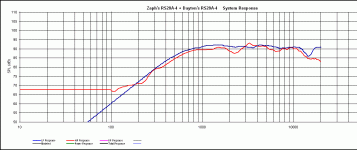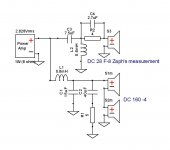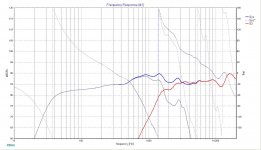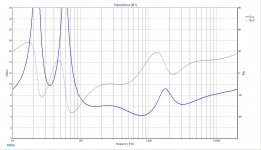I fiddled around a little more and came up with this one. I ultimately turned the LPF into a 2nd order around 1500Hz which smooths out those goofy speedbumps at the XO by dropping the massive woofer peak while the tweeter is still 2nd order at 2k. I also got rid of that notch filter thing and added Erik's favorite symbols.  I've left the tweeter 8ohm resistor there for now, which drops the tweet by 4dB - although the jury still seems to be out on the accuracy of PE/Dayton's measurements other than they're wrong. Either way, it's super easy to pop in, or take out.
I've left the tweeter 8ohm resistor there for now, which drops the tweet by 4dB - although the jury still seems to be out on the accuracy of PE/Dayton's measurements other than they're wrong. Either way, it's super easy to pop in, or take out.
I tried whipping up a version where I hooked the DC160-4's in parallel, which looked quite nice actually - until I looked at the impedance graph and realized it would ultimately become a 2-3 ohm speaker. Shoulda seen that one coming.
Shoulda seen that one coming. 
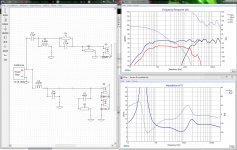
My goals for this speaker are:
A) Make a reasonable first full-range speaker with a crossover that I (mostly) designed
B) Loud enough that it can easily be used for shop speakers or an outdoor boombox or tailgate with good, solid sound - but no critical listening will be done on these speakers, so I don't need to spend hours modeling and buying expensive mics and such to measure it out properly.
WinISD says that 2x DC160-4's in 1.2 ft^3 tuned to 38Hz will play at 104 dB at 50w without running out of cone excursion. F3 is at 35Hz and F10 at 28. Given that I haven't modeled the baffle or distances, would my goals be reasonable with this setup, or does baffling and distancing really play a huge enough factor that it would actually sound significantly different to the 'normal' ear that's not listening critically at a backyard party?
I tried whipping up a version where I hooked the DC160-4's in parallel, which looked quite nice actually - until I looked at the impedance graph and realized it would ultimately become a 2-3 ohm speaker.

My goals for this speaker are:
A) Make a reasonable first full-range speaker with a crossover that I (mostly) designed
B) Loud enough that it can easily be used for shop speakers or an outdoor boombox or tailgate with good, solid sound - but no critical listening will be done on these speakers, so I don't need to spend hours modeling and buying expensive mics and such to measure it out properly.
WinISD says that 2x DC160-4's in 1.2 ft^3 tuned to 38Hz will play at 104 dB at 50w without running out of cone excursion. F3 is at 35Hz and F10 at 28. Given that I haven't modeled the baffle or distances, would my goals be reasonable with this setup, or does baffling and distancing really play a huge enough factor that it would actually sound significantly different to the 'normal' ear that's not listening critically at a backyard party?
Last edited:
A typical flat baffle will support mostly forward radiation of the high and middle frequencies, but will be too small to hold the lower frequencies. These will wrap around and the room walls will get involved.
At middle/lower frequencies this discontinuity will appear for all intents and purposes as a continuation of the baffle at some frequencies and potentially as much as a complete loss at others based on the extra distance travelled.
If you took a set of box speakers outside away from walls you'd see a somewhat smoother middle ground amounting to a -6dB reduction in the bass. Baffle step compensation is a reduction of the middle and higher frequencies based on this middle ground assumption. Room placement and baffling techniques can be used to bring the in room case closer to this assumption.
At middle/lower frequencies this discontinuity will appear for all intents and purposes as a continuation of the baffle at some frequencies and potentially as much as a complete loss at others based on the extra distance travelled.
If you took a set of box speakers outside away from walls you'd see a somewhat smoother middle ground amounting to a -6dB reduction in the bass. Baffle step compensation is a reduction of the middle and higher frequencies based on this middle ground assumption. Room placement and baffling techniques can be used to bring the in room case closer to this assumption.
yup U need to model baffles, my instinks (sic) say your design will be more of a near field aka light on bass in larger spaces. Why? Because BSC is changed significantly. Yours needs double the L since you raised impedance to 2x the above the other design. unless you have hugely increased baffle faces or have fixed it in a corner wall.Given that I haven't modeled the baffle or distances, would my goals be reasonable with this setup, or does baffling and distancing really play a huge enough factor that it would actually sound significantly different to the 'normal' ear that's not listening critically at a backyard party?
BSC is largely compensated using 1st order from the total combination of series L at the speaker impedance Xsp calculated roughly when F (baffle width) is at -3dB /half power (Xsp=2*PI*F*L). You may get more spl's for the outside party but at a much leaner sound. that is why for 2nd order the L and C ratios don't follow normal electrical filter theory.
IDK but the d'appolito array was originally designed for 3rd order only, but that may have changed? see John K web site
Last edited:
Thanks Lojzek!
what and I'm chopped liver? at least I'm no 'sim' data queen, ha
Knowledge, a couple of tools along with LTSpice gets me there too
like someone else here noted, you should NOT blindly take data from others and crunch it w/o expectation of the end results.
crap data in = crap data out
Last edited:
what and I'm chopped liver? at least I'm no 'sim' data queen, ha
Well, I appreciate the effort, but I really have no idea what you said in your post with all of the BCS, double L's, L and C ratios, etc... I'm sure it makes sense to you all since you've been doing this stuff for years. You're geeking out on techy bits instead of using newbie language, then building from there. I gather that essentially the smaller the baffle, the more the mid and bass will 'wrap around' the enclosure and not send it forward, which may be ok for a room, but will sound thin in larger areas. Lojzek went the extra mile and simed it all out for a good visual without my even asking.
Knowledge, a couple of tools along with LTSpice gets me there too
like someone else here noted, you should NOT blindly take data from others and crunch it w/o expectation of the end results.
crap data in = crap data out
Agreed, but as I mentioned before, I'm not interested in investing many hours and spending hundreds of dollars on 'proper' modeling techniques and equipment, nor am I looking for a 'perfect' speaker as this is my first full-range build. Go re-read my speaker goals.
Infinia was trying to tell you that your initial filter made for
4 ohm nominal impedance ( 2 of 8 Ohm units in parallel)
has to be changed to accomodate for a new nominal
impedance of 8 Ohm( 2 of 4 Ohm in series). In order to
do that you would double the inductance value of an inductor
in series with woofers and since the situation gets complicated
regarding the space you want your speakers installed, this
may influence the filter parts values in a way that you may
end up using completely different values. In short, the closer
your speakers are to the walls, the less you need to think
about BSC. The farther you get out in free space the more
you need BSC so it sounds fuller.
Shall I attach the 4 ohm woofer frd's and bass reflex zma's
along with Zaph Audio tweeter frd and then you can play
with it?
4 ohm nominal impedance ( 2 of 8 Ohm units in parallel)
has to be changed to accomodate for a new nominal
impedance of 8 Ohm( 2 of 4 Ohm in series). In order to
do that you would double the inductance value of an inductor
in series with woofers and since the situation gets complicated
regarding the space you want your speakers installed, this
may influence the filter parts values in a way that you may
end up using completely different values. In short, the closer
your speakers are to the walls, the less you need to think
about BSC. The farther you get out in free space the more
you need BSC so it sounds fuller.
Shall I attach the 4 ohm woofer frd's and bass reflex zma's
along with Zaph Audio tweeter frd and then you can play
with it?
in laymans speak ( I think )
take your 2nd order low pass filter, if you make L dominate it behaves like a 1st order filter before the C kicks in. .
use the classic formula for Xl = 2*PI*F*L at the half power Xl = R load (speaker impedance by definition) use this to compensate for baffle loss. (valid assumption assuming effects of LC is more than a couple of octaves away.)
then solve for L given the baffle dimensions estimate frenquncy when response falls by half.
select L from a vendor and model Rdc parasitic losses in your favorite bass box calculator.
https://trueaudio.com/st_diff1.htm
see Home of the Edge
take your 2nd order low pass filter, if you make L dominate it behaves like a 1st order filter before the C kicks in. .
use the classic formula for Xl = 2*PI*F*L at the half power Xl = R load (speaker impedance by definition) use this to compensate for baffle loss. (valid assumption assuming effects of LC is more than a couple of octaves away.)
then solve for L given the baffle dimensions estimate frenquncy when response falls by half.
select L from a vendor and model Rdc parasitic losses in your favorite bass box calculator.
https://trueaudio.com/st_diff1.htm
see Home of the Edge
I thought I already compensated for the ohm change...? My inductor value increased by .2mH, I changed it into a 2nd order, and I dropped the crossover point by 500Hz to boot. At this point, I'm not really worrying about the speaker placement as it's intended to be a very portable setup and not sitting in one particular spot at all. I just want to get it sounding "pretty smooth" in an outdoor environment for this one. More complicated and proper versions may follow, but I don't need to go too crazy on my first build. I should figure out how to add a baffle to Xsim though...
Sure! If it's not too much bother, that would be awesome!
Sure! If it's not too much bother, that would be awesome!
that's the 1st step in any good speaker design deciding how much baffle loss your going to tolerate, everything else follows. it's not a simple tweek unless your spare inductor /parts pile is large. Id assume the design your basing yours on has been voiced for decent bass so simply scale it by a factor of 2* (0.6+0.2)=1.6 mH. otherwise... enjoy your lean-n-loud but less sensitive speaker
Last edited:
I find this spreadsheet great for adding in baffle step effects to FRD's http://audio.claub.net/software/jbabgy/FRM.html and have a read of Dave Dal Farra's tutorial too http://audio.claub.net/software/DaveDalFarra/Simple%20Loudspeaker%20Design%20ver2.pdf
It should give you a much better idea of all of the things necessary when simulating with measurements other than those done on your own baffles.
edit: if you are going to be mainly using these outside (I assume well away from any walls) Then dealing with the baffle step is WAY more important
Tony.
It should give you a much better idea of all of the things necessary when simulating with measurements other than those done on your own baffles.
edit: if you are going to be mainly using these outside (I assume well away from any walls) Then dealing with the baffle step is WAY more important
Tony.
Last edited:
- Status
- This old topic is closed. If you want to reopen this topic, contact a moderator using the "Report Post" button.
- Home
- Loudspeakers
- Multi-Way
- Help breaking down the Dayton III crossover
